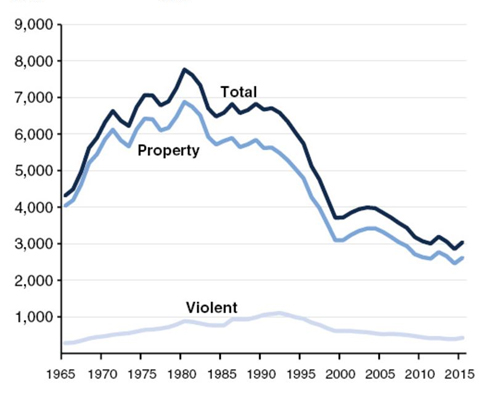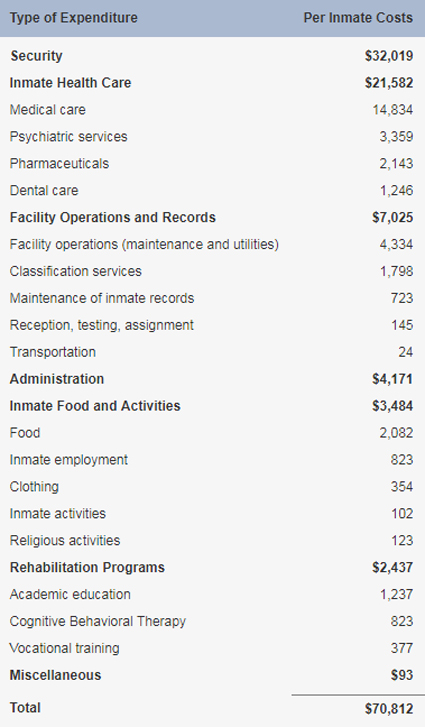Innovative Incarceration: Lower Costs, Safer Citizens
The average annual cost to house a prisoner in California is $71,000, and according to the California’s Legislative Analyst’s Office, the cost has risen 45% since just 2011. And as costs have soared, California’s policymakers have resorted to creative ways to release inmates from California’s overcrowded prisons. But what if that Californian creativity could be harnessed to lower the cost of incarceration?
This process began in 2011, when the US Supreme Court ruled that California must reduce its state prison population to no more than 137% of its design capacity within two years. In an attempt to comply, the state legislature passed Assembly Bill 109, which required non-violent, non-serious, and non-sexual offenders with sentences of longer than one year to be housed in county jail facilities rather than state prisons.
Because AB 109, the so-called prison “realignment,” merely shifted costs for incarceration from the state to the counties, two additional measures of significance were passed in an attempt to reduce the overall inmate population. These were sold to voters as reform initiatives, and both of them passed with substantial majorities. Prop. 47, passed in 2014, reclassified several felonies as misdemeanors, which had the effect of reducing prison sentences in new cases, and earlier release for prisoners sentenced for crimes no longer classified as felonies. Prop. 57, passed in 2016, granted early release opportunities to inmates with good behavior who had committed non-violent crimes.
These measures resulted in the early release of tens of thousands of inmates onto California’s streets. Since enactment, violent crime has increased in California, although the data is mixed. For example, according to the FBI, while violent crime in California increased in 2015 and 2016, it increased across most of the U.S. in those years. As stated in a recent study by the Public Policy Institute of California, “California’s violent crime rate increased by 3.7% in 2016 to 444 per 100,000 residents. There have been other recent upticks in 2012 and 2015, but the statewide rate is still comparable to levels in the late 1960s.”
More recently – most crime statistics for 2017 are not yet available – the LA Times reports that in 2017 “in Los Angeles, homicides are down, but violent crime is up.” A big picture perspective on crime trends in California can be seen in this graphic produced by Politifact.com using data from the California Legislative Analyst’s Office:
California Crime Trends – Crime Rates per 100,000 Residents

As can be seen, rates of crime in California rose throughout the 60s and 70s, reaching a high plateau that lasted right up until around 1994, when California passed the three strikes law. After that, crime rates fell precipitously for years, reaching historic lows. Since 2014, rates of crime have been rising, even though they remain relatively low from a historical perspective.
But why should we be happy with a 0.4% rate of violent crime? Why should 4% of Californians be victimized by a violent criminal in any given decade? And who’s to say that crime rates would not have continued to decline, if it weren’t for the passage of Props. 47 and 57?
More to the point, whether or not Californians should or should not incarcerate more criminals, or impose longer sentences on criminals, Californians don’t have that option. Because it costs too much to house prisoners in California. How can California house more inmates without building more conventional prisons, which are staggeringly expensive?
An excellent resource prepared by BackgroundChecks.org shows the costs per prisoner in other states. Nevada, our neighbor to the east, only spends $17,851 per year per prisoner. Alabama has the lowest cost, at $14,780 per prisoner. Arizona, $25,397. Even Oregon and Washington, California’s left coast comrades in bloated inefficient government excess, manage to spend far less than California does, paying per prisoner costs of $44,021 and $37,841, respectively.
Why?
When you read up on costs per prisoner in other states, the results are somewhat amusing. Because in those states, the conventional wisdom is that costs are out of control. Alabama’s costs per prisoner have “doubled since 2003.” In Nevada, “overtime costs continue to mount.” Imagine that. But in all states, the same factors contribute to rising costs to house prisoners. California just spends more, in every category. Here is a table from California’s Legislative Analyst’s Office showing details of the cost per prisoner.
California’s Costs per Prisoner – Itemized Costs

It’s likely these costs are understated. Does “Security” include the additional amounts that will be necessary to properly fund the pensions that are due our correctional officers? Does “Facility Operations” include the payments on the billions that have been borrowed by the state to construct California’s 34 state prisons?
In the recently approved California state budget for 2017-18, $11.4 billion is allocated to the Department of Corrections, up another $286 million (2.6%) from last year. But again, this doesn’t begin to represent the true cost to taxpayers. A recent UCLA study estimated the cost of incarceration for just the County of Los Angeles at nearly $1.0 billion last year.
It’s likely the total cost to California’s taxpayers to incarcerate criminals – taking into account state and local expenses – is easily twice the $11.4 billion budgeted by the state. And these inflated costs can be attributed to two causes. First, the excessive costs caused by unionized government – pensions in particular, and excessive costs to build state prisons, caused by a union controlled state legislature requiring needlessly expensive project labor agreements. Second, and arguably even more significant, the overall excessive cost-of-living in California – also a byproduct of policies enacted by California’s union controlled state legislature – which makes everything more expensive.
The burden of realignment – foisting responsibility for state prisoners back onto the counties where they were convicted – is also an opportunity. Because counties, like states in our federal system, are laboratories of democracy, laboratories of policy. Why can’t California’s counties experiment with new modes of incarceration. If inmates are sequestered to Cal Fire to work the fire lines, why can’t they do other tasks throughout the rural regions of California? Why not use inmates to improve rural access roads, remove dead trees from our drought-stressed forests, or even work in agriculture?
While many inmates may be too dangerous to do this sort of work, with new technologies to monitor and control prisoners, it is possible that prisoners who would not be viable candidates for these programs in the past would be qualified today. Electronic monitoring devices are becoming increasingly sophisticated. Why not use these devices to monitor not only location, but heart rate or, who knows, even brain waves or other physical indicators of imminent fight or flight? Wouldn’t adding additional capabilities to these devices allow more effective means to deter escape and even prevent violence? Why not use swarms of inexpensive drones to hover in the vicinity of inmates, reducing the number of guards required, and replacing some or all layers of expensive security fencing? Why not equip these drones with nonlethal means to prevent escape or violence?
Law enforcement has stayed abreast of new technologies and that is one of the reasons rates of crime are down sharply across America. While the impact of new technologies must be constantly scrutinized, and some of them may be problematic, there is no reason not to extend these tools beyond law enforcement into the corrections industry. It’s reasonable to assume most inmates would prefer a virtual prison to the penitentiary. One that afforded them mobility, equal or greater safety, a mission, a chance to engage in a vocation, and fresh air. Such innovation might also bring welcome relief to taxpayers.
* * *
